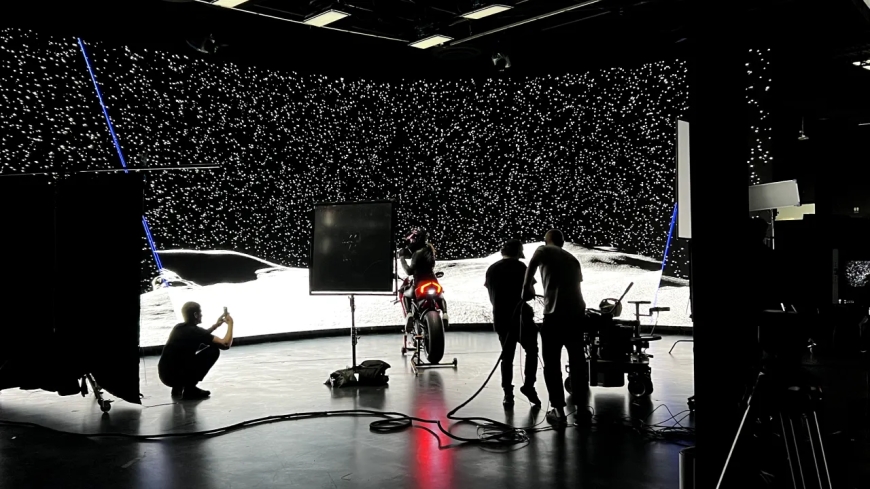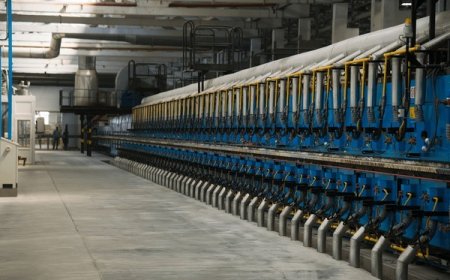Revolutionizing Filmmaking: The Power of Virtual Reality Production Studios and LED Walls
The filmmaking industry is undergoing a transformative shift, driven by cutting-edge technologies that are redefining how stories are told on screen.

The filmmaking industry is undergoing a transformative shift, driven by cutting-edge technologies that are redefining how stories are told on screen. Among these innovations, Virtual Reality Production Studios and LED Walls have emerged as game-changers, offering filmmakers unprecedented creative control, cost efficiency, and immersive storytelling capabilities. This guest post explores how these technologies are revolutionizing the production process, their benefits over traditional methods, and their impact on the future of filmmaking.
What is a Virtual Reality Production Studio?
A Virtual Reality Production Studio is a filmmaking environment that integrates advanced technologies such as LED walls, real-time rendering engines, camera tracking systems, and extended reality (XR) to create immersive, dynamic sets. Unlike traditional green screen setups, these studios use large-scale LED walls to display photorealistic backgrounds and environments in real time, allowing actors, directors, and crew to interact with a virtual world during filming. This approach, often referred to as virtual production, blends physical and digital elements to produce seamless, in-camera visual effects that reduce the need for extensive post-production.
Virtual production studios are equipped with a suite of tools that include:
- LED Video Walls: High-resolution screens that display virtual sets, replacing traditional green screens.
- Real-Time Rendering Engines: Software like Unreal Engine that generates and displays virtual scenes instantly.
- Camera Tracking Systems: Technology that synchronizes camera movements with the virtual background for accurate perspective.
- Motion Capture: Systems that integrate computer-generated characters or objects with live-action performances.
These components work together to create a cohesive, immersive environment that enhances both the creative process and the final product.
The Role of LED Walls in Virtual Production
At the heart of a virtual reality production studio lies the LED wall, a massive, high-resolution display composed of modular LED panels. These walls serve as dynamic backdrops that project virtual environments, ranging from sprawling sci-fi landscapes to intimate urban settings, all without leaving the studio. Unlike green screens, which require post-production to insert backgrounds, LED walls deliver final-pixel imagery in-camera, allowing directors to see the finished shot during filming.
LED walls have become the cornerstone of virtual production due to their ability to:
- Create Immersive Environments: Actors can perform within a realistic setting, improving their performance by providing tangible visual cues rather than imagining a green screen environment.
- Enhance Lighting Realism: The ambient light emitted by LED walls naturally interacts with actors and physical props, producing authentic reflections and shadows that eliminate the artificial look often associated with green screen compositing.
- Reduce Post-Production Costs: By capturing high-quality visuals in-camera, LED walls minimize the need for time-consuming and expensive post-production processes.
- Enable Real-Time Adjustments: Directors and cinematographers can tweak backgrounds, lighting, and effects on the fly, streamlining the creative process and reducing the likelihood of reshoots.
The use of LED walls has been popularized by high-profile productions like The Mandalorian, which utilized a massive LED volume known as "The Volume" to create its iconic Star Wars universe. This technology, often referred to as StageCraft, has set a new standard for virtual production, inspiring studios worldwide to adopt similar setups.
Benefits of Virtual Reality Production Studios and LED Walls
The adoption of virtual reality production studios and LED walls offers numerous advantages over traditional filmmaking methods. Here are some key benefits:
1. Enhanced Creative Freedom
LED walls allow filmmakers to create virtually any environment imaginable, from fantastical alien planets to historical settings, without the logistical challenges of on-location shooting. The flexibility of virtual production enables rapid scene changes, allowing productions to switch between locations or times of day in seconds. This versatility is particularly valuable for projects with tight schedules or complex creative briefs.
For example, a commercial shoot for a car brand can seamlessly transition from a desert highway to a bustling cityscape without moving the crew or equipment. This capability empowers directors to experiment with bold visual concepts, fostering innovation in storytelling.
2. Cost and Time Efficiency
Traditional filmmaking often involves significant expenses for location travel, set construction, and post-production visual effects. Virtual production studios eliminate many of these costs by bringing the world to the studio. By displaying final-pixel imagery in-camera, LED walls reduce the need for extensive CGI work, saving both time and money. Additionally, the ability to make real-time adjustments minimizes the risk of costly reshoots.
A post on X highlighted the cost-effectiveness of hybrid workflows, combining LED walls with green screens for smaller productions, making virtual production accessible to mid-sized studios without breaking the budget.
3. Improved Actor Performance
Acting against a green screen can be challenging, as performers must rely on imagination to interact with environments that will be added later. LED walls solve this problem by providing actors with a tangible, immersive setting. The realistic visuals displayed on the walls enhance actors ability to deliver natural, convincing performances, as they can see and react to the environment in real time.
For instance, an actor filming a scene set in a futuristic city can see the towering skyscrapers and neon lights on the LED wall, allowing them to fully immerse themselves in the role. This immediacy not only improves performance quality but also fosters a more collaborative on-set experience.
4. Realistic Lighting and Reflections
One of the standout features of LED walls is their ability to emit light that interacts naturally with the scene. Reflections on metallic surfaces, glass, or even actors skin appear authentic, eliminating the need for post-production corrections to match lighting conditions. This dynamic lighting integration ensures that the final image looks cohesive and believable, a significant improvement over green screen methods.
5. Scalability and Versatility
LED walls are highly modular, allowing studios to customize their size and shape to suit specific projects. From compact setups for intimate scenes to massive 360-degree volumes for expansive action sequences, virtual production studios can adapt to a wide range of genres and formats, including films, TV shows, commercials, and live broadcasts.
Real-World Applications and Success Stories
The impact of virtual reality production studios and LED walls is evident in numerous high-profile projects. The Mandalorian revolutionized the industry by showcasing the power of ILMs StageCraft technology, using a curved LED volume to create immersive environments for the Star Wars universe. The success of this approach has inspired other studios to invest in similar setups.
For example, ARwall, an award-winning virtual production company, offers turnkey solutions for creators at all levels, integrating LED walls with their ARFX software to deliver real-time effects and augmented reality experiences. Their work has been recognized with multiple patents for innovative virtual production methods.
Similarly, ROE Visual has supplied LED panels for major studios like Pixomondos Toronto facility, which features a massive LED volume for blockbuster films. Their Black Pearl 2 series, used in The Mandalorian, is celebrated for its high resolution and HDR capabilities, making it a preferred choice for virtual production.
A post on X by @AOTOElectronics highlighted the advancements in LED technology, noting that their 7680Hz LEDs achieve 94% of the BT.2020 color gamut, pushing the boundaries of real-time imaging for virtual production.
Challenges and Considerations
While virtual production studios and LED walls offer transformative benefits, they also come with challenges. The initial cost of setting up an LED volume can be significant, particularly for smaller studios. Factors such as panel size, pixel pitch, and integration with rendering engines and tracking systems can drive up expenses. However, as technology becomes more accessible, costs are gradually decreasing, and hybrid workflows are making virtual production viable for smaller budgets.
Another consideration is the technical expertise required to operate these systems. Studios must invest in training for crew members to manage real-time rendering, camera tracking, and LED panel maintenance. Companies like Refresh LED offer support and training to help studios maximize the potential of their LED walls.
The Future of Virtual Production
The future of virtual reality production studios and LED walls is bright, with ongoing advancements in LED technology, rendering engines, and XR integration. As pixel pitches become smaller and refresh rates higher, LED walls will deliver even more stunning visuals, further blurring the line between virtual and real worlds.
The adoption of virtual production is also expanding beyond film and television. Industries such as live events, advertising, education, and gaming are leveraging LED walls to create immersive experiences. For example, virtual concerts and product launches are using XR stages to engage audiences in real time, offering cost-effective and visually spectacular presentations.
Moreover, the environmental benefits of virtual production cannot be overlooked. By reducing the need for location shooting and physical set construction, studios can minimize their carbon footprint, making virtual production a more sustainable choice for the industry.
Conclusion
Virtual reality production studios and LED walls are reshaping the filmmaking landscape, offering filmmakers unparalleled creative freedom, cost efficiency, and immersive storytelling capabilities. By replacing traditional green screens with dynamic, high-resolution LED displays, these technologies enable directors to capture final-pixel imagery in-camera, streamline production workflows, and enhance actor performances. As the technology continues to evolve, virtual production is poised to become the standard for modern filmmaking, opening up new possibilities for creators across industries.
Whether youre a filmmaker looking to push creative boundaries or a studio aiming to optimize production efficiency, embracing virtual reality production studios and LED walls is a step toward the future of visual storytelling. To learn more about implementing these technologies, explore offerings from leading providers like ARwall, ROE Visual, and Refresh LED, and consider how virtual production can elevate your next project.











































